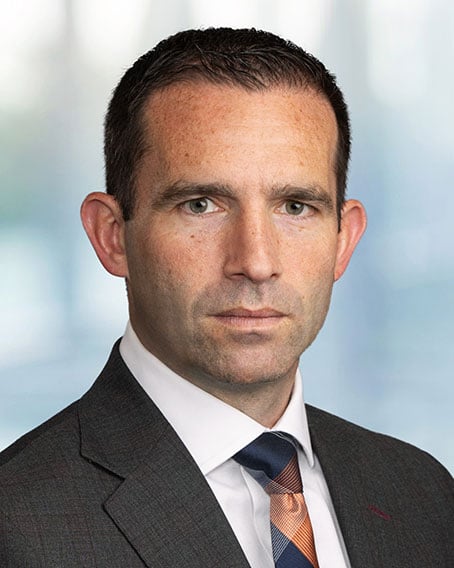The pending Supreme Court case of Impression Products v. Lexmark International could affect what companies and consumers do with products they buy, based on the doctrine of patent exhaustion. Following oral argument on March 21, Megan Baca and Matt Rizzolo from Ropes & Gray’s intellectual property practices discuss the background of the case and potential consequences.
Transcript:
Matt Rizzolo: Hello, I’m Matt Rizzolo, IP litigation counsel in the Washington, D.C. office of Ropes & Gray. Today I’m joined by my colleague Megan Baca. Megan is a partner in Ropes & Gray’s intellectual property and technology transactions practice group, and is resident in the firm’s Silicon Valley office. In today’s special bicoastal edition of our Supreme Court podcast, we’re going to talk about a Supreme Court case that may have an effect on what consumers can do with products that they buy—the pending case of Impression Products v. Lexmark International, which was argued on March 21. What’s this case about?
Speaker: This case is about patent exhaustion, which deals with the rules about what happens to patented products after they are sold. Generally, in patent law, after a company sells a patented product, it can’t control what customers do with that product after buying it. That means that the patent owner has “exhausted” its rights in the patented product. So as the customer, you can re-sell the product or give it away, and you can break it, throw it away, or use it for an entirely different purpose.
Matt Rizzolo: I promise that I will do my best today to avoid any bad puns about being exhausted. Patent exhaustion is also sometimes called the “first sale” doctrine, isn’t it?
Speaker: Yes, that’s right. Here, what were being sold were patented printer cartridges. Lexmark makes and sells toner cartridges under two different sales programs. Under the regular program, you can buy a cartridge at full price, without any restrictions at all—once you buy it, you can sell it to other people, re-use it, re-fill it, etc. But under Lexmark’s “Return Program,” a customer is able to buy the cartridges at about a 20% discount, but in exchange, has to agree not to re-use them or re-sell them to anyone else. Lexmark also puts chips in their cartridges to prevent people from re-filling them.
Matt Rizzolo: So who is Impression Products? How did they become involved?
Speaker: Impression Products is a small company in West Virginia who makes and sells aftermarket cartridges for dozens of different printers and copiers. As part of their business, Impression purchases used Lexmark cartridges from Lexmark’s customers and then refurbishes, re-fills, and re-sells these cartridges to new customers. Lexmark sued Impression for patent infringement, but Impression has argued that Lexmark’s patent rights were exhausted when Lexmark first sold these cartridges, so Lexmark cannot now use patent law to restrict what customers do with the printer cartridges.
Matt Rizzolo: Megan, how does a case about printer cartridges affect companies and consumers?
Megan Baca: The outcome of this case could be important for the public because it affects what people can do with the products they buy. For companies, the issue is whether they can buy and re-sell products without worrying about patent infringement. This involves products sold both in the United States and in other countries. For individual consumers like the three of us, there isn’t as much risk because companies generally don’t sue end users for patent infringement—that’s generally bad business. For example, Lexmark didn’t choose to sue its own customers for selling the spent cartridges to Impression Products. But for end users, if patent owners can keep greater control over their products, it’s possible that prices for certain goods could be higher.
Matt Rizzolo: I imagine that there are probably many companies who use a business model similar to Impression’s in other industries who are watching this case closely, too.
Megan Baca: Absolutely. This case will impact all manner of businesses that sell articles into a supply chain, where the seller would like to control the use of its article farther downstream in the supply chain – such as by limiting resale in undesired markets, restricting sales to competitors, or placing other restrictions on the use of the article.
Matt Rizzolo: Now, turning to the specific issues that were presented to the Supreme Court here, I understand there are two questions involving exhaustion – one being domestic, within the United States, and one foreign, outside the country. What is the issue with respect to exhaustion for sales within the United States?
Megan Baca: The first question presented at the Supreme Court is just about so-called “conditional sales,” meaning sales with restrictions on customers, in this country. Those are like Lexmark’s Return Program sales for printer cartridges in the U.S. An important point about this issue is that exhaustion has to be considered together with other unlawful restrictions in patent law. Under antitrust law, there are other doctrines that prevent patent owners from expanding their patent rights. For example, a patent owner can’t engage in “tying,” which is forcing their customers to buy related products. That would be like Lexmark forcing its printer cartridge customers to buy all their printer paper from Lexmark, too.
Matt Rizzolo: Right, and patent exhaustion involves only post-sale restrictions that are otherwise lawful under those antitrust rules. What about the second issue involving foreign sales?
Speaker: The foreign exhaustion issue is simply about whether selling products in other countries also exhausts patent rights in the U.S. So when Lexmark sells their printer cartridges in Germany, for example, does that mean German customers can import those cartridges back into the United States without worrying about infringement? This is also an interesting issue because it implicates extraterritoriality in U.S. patent law. Generally, U.S. patent law applies only in this country, with some limited exceptions.
Matt Rizzolo: Now, the two sides in this case also have different views about the legal source of the patent exhaustion doctrine in the first place. What’s the difference there?
Megan Baca: That’s an important issue, too. The disagreement is whether exhaustion comes from common law, or from the federal patent infringement statute. Impression Products and its supporters claim that patent exhaustion is based on court-made common law. According to historical sources (dating back as far as 1628), courts have generally held that there can be no post-sale restrictions on personal property, so that after you buy a product, you can do whatever you want with it. Lexmark disagrees—it looks to the infringement statute, 35 U.S.C. § 271(a), which prevents others from making, using, or selling a patented product – quote – “without authority.” According to Lexmark, it’s those words “without authority” that cover patent exhaustion. Under Lexmark’s view, the common-law tradition does not apply here, and patent owners can give as many or as few of their rights to their customers as they want, in the form of post-sale restrictions.
Matt Rizzolo: This isn’t the first time the Supreme Court has addressed the issue of exhaustion with respect to IP rights in the last few years, is it? It seems like there also may be some possible overlap with copyright law here.
Speaker: That’s right—in 2013, the Supreme Court decided a case called Kirtsaeng, which involved a student from Thailand buying copyrighted textbooks in Thailand and then selling them for a profit here in the U.S. The Supreme Court said that the publisher exhausted its copyright protections when it sold the textbooks in Thailand, even though it included notices saying that the books were for use only in certain countries. So the question here, is why should patents be treated any differently? Also, the Supreme Court has made some broad statements about the relationship between copyright and patents. For example, in the recently decided the SCA Hygiene case, which dealt with the doctrine of laches, they held that the same principles applied in both the copyright and patent context. The issue of how analogous the copyright and patent laws are in the exhaustion context came up repeatedly during the oral arguments in the Lexmark case.
Matt Rizzolo: Megan, as a transactional lawyer, you deal with IP licenses and IP agreements every day. Why can’t patent owners simply use contracts to enforce post-sale restrictions instead of having to try to raise patent infringement claims?
Megan Baca: That’s an issue that came up at the Supreme Court. Some parties argue that contracts are exactly what patent owners should use, instead of trying to extend their so-called monopoly rights. But the patent owners say that contract law won’t work well – even if the contractual obligation is passed down through contract – because the patent owners are not in privity with downstream customers. So for example, if I buy a printer cartridge from Impression, and I don’t have a contract with Lexmark, Lexmark can’t sue me for breach of contract. And even if companies use contracts, such as shrink wrap agreements or click through agreements, there are still questions about what constitutes proper notice to consumers.
Matt Rizzolo: And as we mentioned earlier, for a number of reasons patent owners probably don’t want to sue their own customers for breach of contract. This is a case that received a lot of attention from a diverse group of interested parties. Who seemed to take an interest in this case?
Speaker: There were a lot of amicus briefs filed. The list includes technology companies like Intel and Qualcomm, groups of law professors, and public interest groups. As Megan noted, many companies and industries could be affected by exhaustion. Retailers like Costco also filed a brief because they’re concerned about patented products in their complex supply chains. Another major group of companies was composed of medical device and pharmaceutical companies. Those companies of course want keep control of their products, but they also argued that stronger patent rights allow them to make sure their medical products and drugs are used safely.
Matt Rizzolo: Oral argument was held on March 21. Did the Justices give an indication of how they’re going to decide this case?
Speaker: The bench was actually pretty cold, and did not ask a lot of questions. Justice Breyer seemed to accept the argument that the principle of “no alienation”—that is, no restrictions on re-selling property—has been established for hundreds of years, which seems to indicate a vote for Impression. Justice Alito, on the other hand seemed skeptical about the issue of foreign exhaustion because U.S. patent law generally doesn’t apply overseas, which would favor Lexmark, at least on the foreign exhaustion issue. Overall, other commentators are expecting a split decision towards the end of the current term in June. It’s worth noting that the last time the Court considered IP exhaustion, in the Kirtsaeng case we just discussed, the Court was divided 6-3.
Matt Rizzolo: Well, I guess now we play the waiting game for the Court’s decision. We’ll get together to do a follow-up podcast after the Court rules. And thank you for listening to this Supreme Court podcast. Please visit our Capital Insights page for more news and analysis on noteworthy issues arising out of Washington, D.C.
Stay Up To Date with Ropes & Gray
Ropes & Gray attorneys provide timely analysis on legal developments, court decisions and changes in legislation and regulations.
Stay in the loop with all things Ropes & Gray, and find out more about our people, culture, initiatives and everything that’s happening.
We regularly notify our clients and contacts of significant legal developments, news, webinars and teleconferences that affect their industries.




